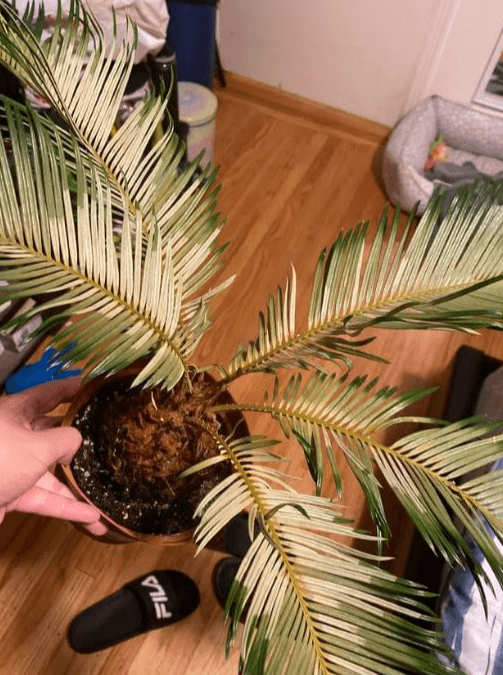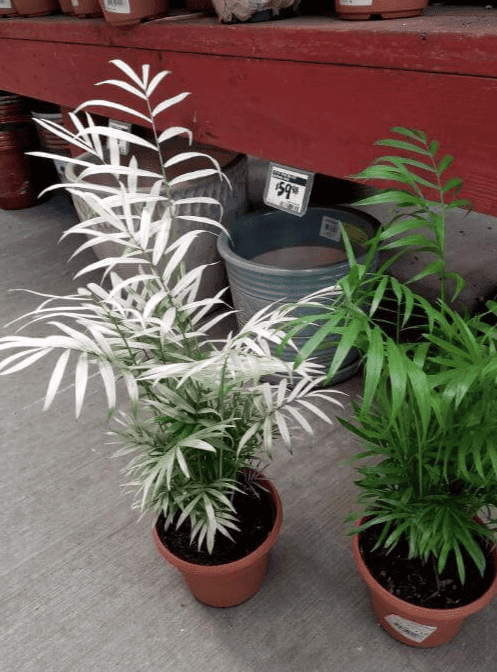Last Updated on June 5, 2023 by a Friendly Gardener
Palm trees, regardless of the species, are appreciated for their tropical beauty and ability to afford a relaxing atmosphere wherever they are located. They are characterized and famous for their long vibrant green fronds. So, when a palm tree leaf starts turning white, alarm bells go off.
There is more than one cause for white palm tree leaves. It may be as simple as improper exposure to sunlight or something more serious like a disease. Here we examine what might be causing your palm’s leaves to turn white and what you can do about it.
Palm Tree Environments
Magnificent palm trees are generally admired in outdoor locations as part of landscaping but many palm tree varieties make lovely indoor houseplants. Parlor palms, for instance, became the rage during the Victorian era as decorative indoor décor in important hotels thanks to lovely large fronds emerging at the top of trees without branches.
Palms find their natural habitats in the tropics hence they prefer some partial shade to generous bright, indirect light. These trees should be planted in a well-draining soil bed that can be neutral to acidic with a pH measuring from 6 to 8. The soil should be maintained evenly moist. Palm trees also tend to suffer from a potassium deficiency, so regular fertilization with a fertilizer containing greater amounts of potassium will help keep your plant healthy.
Causes of Palm Leaves Turning White

Witnessing a vividly green palm frond suddenly turn white can be worrying. While there may be many causes of a color change, here are the most common.
• Excessive Sun Exposure
Believe it or not, indoor palm leaves turning white can be caused by excessive sunlight exposure. If your palm tree is located in a window where it is receiving too much direct sunlight, fronds will begin to yellow, eventually becoming white in hue. These plants do require generous amounts of bright, indirect sunlight. They do, however, prefer some partial shade rather than strong direct, and often harsh sunlight.
What to do
If you suspect that sun exposure is to blame for your plant’s white leaves, move your palm to a spot that offers partial shade. You can also try moving it further back from the window so that the light it receives is less intense and more indirect.
• Water Quality

Your palm tree may have fronds that are not turning white but experiencing a white mineral buildup. When you use municipal mineral water that contains significant quantities of hard minerals, a white film can form on the leaves. The forming of a white film is common when water supplies contain lots of calcium or lime.
Or in the case of majesty palm leaves turning white, it may be a case of overwatering. Excessive watering can cause fronds to whiten due to fungal infections that cause the discoloration of leaves
What to do
If your municipal tap water is hard, you’ll need to use filtered water instead. Collected rainwater is a fantastic solution although filtered and distilled water can work as well. Set a barrel in your yard or on a deck, porch, patio, or balcony to benefit from the next rainfall. It’s important to remove the mineral content from the water you are providing as this is the principal reason for white films developing on leaves.
If overwatering is the issue, remember that soil beds should be evenly moist but never soggy. If the soil is soggy, consider repotting your palm.
• Inadequate Nutrition

A lack of proper nutrients can create problems for a palm tree and cause leaves to turn white. Perhaps the most important nutrient for palm tree cultivation is potassium. Ideally, a fertilizer specifically formulated for palm tree varieties containing a higher amount of potassium should be used to feed your palm.
What to do
Potassium is essential to a palm tree’s health. When cultivating an indoor palm tree, a fertilizer rich in potassium is recommended. Palm trees should be fed regularly to ensure that this mineral is never lacking.
• Improper Drainage
If your palm is potted in a soil mix that does not drain sufficiently, root rot can set in. Palm trees do not enjoy sitting in standing water or soggy soil.
What to do
Well-draining soil beds are fundamental to the health of palm tree root systems. These plants when left standing in water are susceptible to root rot. If you suspect poor drainage to be the cause of your palm plant leaves turning white, you may want to try adding some organic material to the soil bed. You can also opt to repot your palm using a soil mix that contains perlite, pumice, or similar to encourage drainage and aerate root systems adequately.
• Pest Infestations

Several sap-sucking pests enjoy feeding on palm tree leaves. Scale insects, spider mites, mealybugs, or aphids are all common culprits found taking up residence on palm trees. Pests increasingly weaken a plant, opening the door to infections and diseases.
What to do
The best thing you can do to protect your palm tree from pest infestations is to examine it often and regularly. If there are signs of pests, it’s important to intervene immediately before pests do significant damage as pests generally proliferate rapidly. A natural organic pesticide is neem oil which will not harm humans or pets. Horticultural oils or insecticidal soaps work well too.
What About White Spots?

Even if entire palm leaves are not turning white, white spots may be an alarm bell as well. White spots can indicate a fungal infection, lime deposits, or an infestation of scale insects.
Graphiola leaf spot is usually associated with white spots on palm tree fronds. It is not lethal and is harmless, yet it ruins the tree’s aesthetic. Neem oil, which is also a natural fungicide may be a good solution.
Lime deposits are caused by hard municipal water. These also are not dangerous but again will ruin the beauty of your palm. They can be removed by wiping the front with a soft cloth, but to prevent further spotting use collected rainwater or filtered water.
Scale insects small, oval-shaped bugs with hard shells. They latch on to leaves and stems to suck the sap from within. They will kill your palm if left untreated as they will drain essential nutrients from the plant. Use neem oil or a pesticide formulated for scale insects.
A Final Consideration
White palm leaves or spots on leaves can be caused by a variety of issues. It’s important to identify the cause promptly and treat it accordingly to protect your lovely plant.

